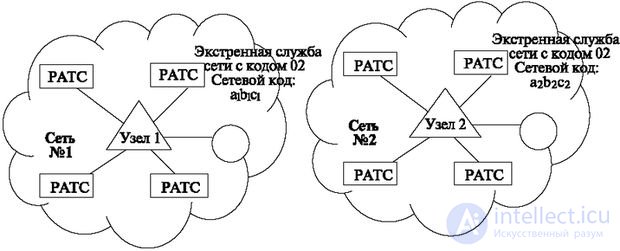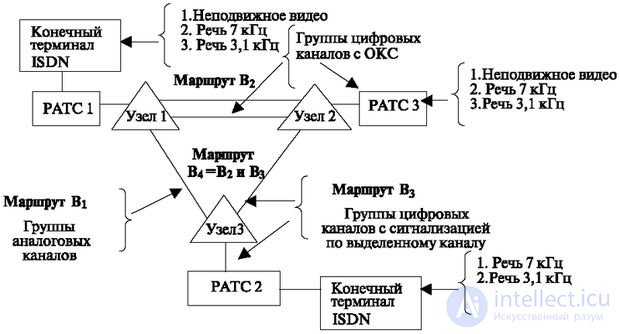Lecture
Tasks facing routing may be different. In this regard, the routing algorithms also differ. In fig. 8.12, routing is shown, which selects different routes for the same code value.

In this example, the same emergency service (in the figure it is shown in a circle) is distributed in different parts of the network, but has the same code 02. For example, the police, which has district offices. When dialing the number 02, it is desirable that the connection be established not with the central service, but with the nearest police station. Routing uses the sign that an outgoing call belongs to this network. In this example, the network, whose numbering starts from index 1 a 1 b 1 from 1 xxx, network node No. 1, having determined that the outgoing subscriber number belongs to this station, will select the route to its emergency service using code 02. Similarly, the network node 2 will work (with network numbering a 2 b 2 с 2 ххх). This routing is called outbound dependent. To implement it, a small correction of the fields in the routing algorithm is required, which the reader can think out independently.
In fig. 8.13 shows an example of routing depending on the requirements for the transmission medium and the ISDN service used [27, 35, 39].

At one of the stations (rats 1) there is the possibility of using several ISDN services. It is required to provide call routing with RATS 2 and RATS 3 stations capable of supporting these services in accordance with the requirements for these services. The picture has a network with various types of channels on network sections (analog, digital) and various types of signaling.
One of them, the 3kHz speech service, does not require digital channels and any signaling system is sufficient for it. Therefore, for it at the nearest node (node 1) is selected by the main route B1, the rest are assigned bypass routes and are selected in case of failure of the main one.
A 7 kHz speech service requires a digital channel, and an SS7-7 signaling is not necessary, but it is also acceptable in the absence of paths of the required quality to use other routes with speech quality deterioration. Therefore, for this 7kHz service, a B4 route with consecutive B2 and B3 sections may be proposed, but a B 1 route calculated for the 3 kHz speech service is possible.
And, finally, for the "still video" service, only a digital channel with the OKS-7 signaling system is required, therefore only the route B 2 is suitable for it.
For routing, one of the SSN messages contains information about channel requirements and type of signaling.
Routing algorithms must provide paths with the smallest number of transits between outgoing and incoming connection points when performing a given quality of service. Quality of service is understood as a complex characteristic that determines the class and quality of services in telecommunications networks [50]. In addition, the total telephone load (the number of busy lines multiplied by the time of their occupation) on the network depends on the way the lines are seized during routing. The more channels are occupied in one connection, the worse the use of the network.
Irregularity of load on the time of day or due to emergencies in different parts of the network can lead to failures due to congestion (obvious loss and time loss) and makes static routing unprofitable, which does not alter the routes initially assigned to it between the two endpoints. Usually, for old networks, routes were fixed by the Network Master Plan and determined by the design organization on the basis of calculations [42]. Ensuring the reliability of the network by cross-switching and methods equivalent to it has already been considered. In addition to this, methods for managing network traffic flow are being developed.
The following routing methods are available: fixed and dynamic.
With the fixed method, routes are developed and laid in advance in the work program of all stations (for example, when developing a network master plan).
In this case, reserve options are specified, which are included on a schedule or in emergency cases. Addition of this is to provide operators of the Service Center with the right to change the routing plans, switch channels from one direction to another on large and responsible networks (for example, Moscow or St. Petersburg). They are given the ability to manage the network in case of emergency situations. At the same time, decision support programs are developed that provide the operator with information about the choice and consequences of each choice. With dynamic control routing is carried out using a variable matrix of directions. The data of this matrix changes in accordance with the situation on the network. At the same time, the correction of data on routes between stations and the collection of information for decision-making (the importance of the directions to which the channels are switched, and the one from which they are withdrawn, the magnitude of the load in these directions in Erlang, the loss in promils) can be carried out by centralized and decentralized . Each of these methods has its advantages and disadvantages [39].
With routing, the problem of eliminating "loops" when setting a route should be solved.
The effect of "looping" occurs when dynamic routing, if the connection returns to one of the already completed sections and the search continues indefinitely through the cycle.
One of the methods to combat this phenomenon is the recording of the sections covered (with a limited number of them) in the alarm format.
The cases of interaction in the routing of public networks with networks of mobile objects and intelligent networks were considered earlier. In addition to general routing issues with such types of communication, the task of re-routing arises when, for example, the subscriber used the service "transfer connection to another number". It is possible to receive in the opposite direction a new number, according to which you need to re-establish the connection, which is a feature of routing in this case.
The importance of synchronous operation of stations has already been considered in previous sections. We have already noted that the central station generators adapt to each other. The principles of such mutual adjustment of all network generators [23] will be briefly discussed below.
In this case, the total synchronization frequency is set due to the fact that all nodes in the network (Fig. 8.14) exchange reference frequencies (this method is called "democratic").

At each reference node, the incoming frequencies are averaged (see the principle of constructing the reference generator). This result is further applied as a clock frequency for local use. At the end of the initial installation period, the network clock frequency usually tends to one stable single frequency.
The advantage of this method is to preserve the operability of the network when one or more reference generators fail.
The disadvantage is that when deviations occur, there is a long process of entering into stable operation, which disrupts the operation of the entire network.
Comments
To leave a comment
Telecommunication Services and Devices
Terms: Telecommunication Services and Devices